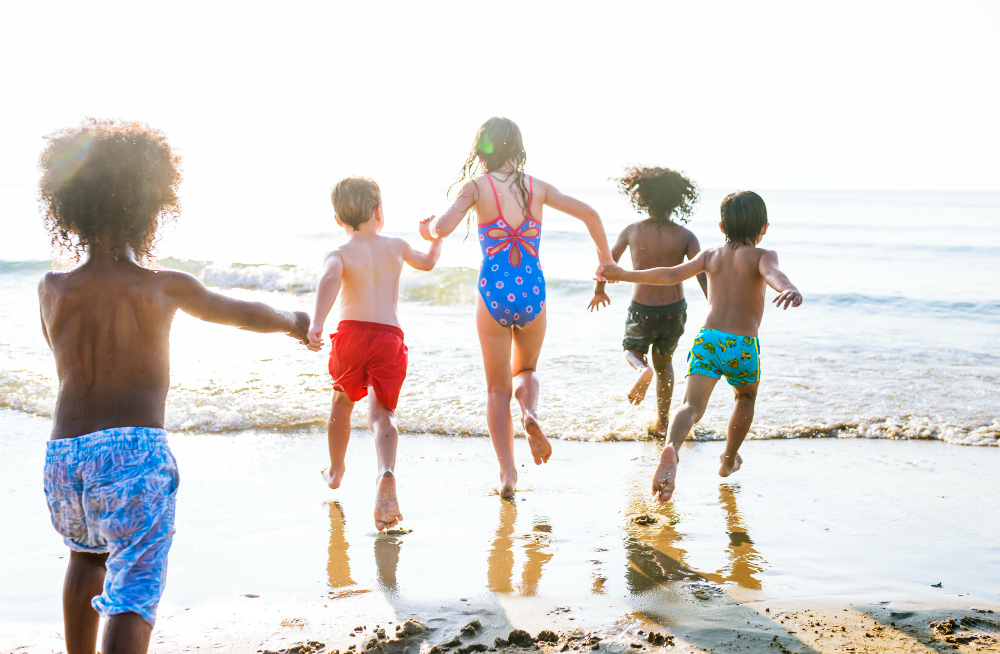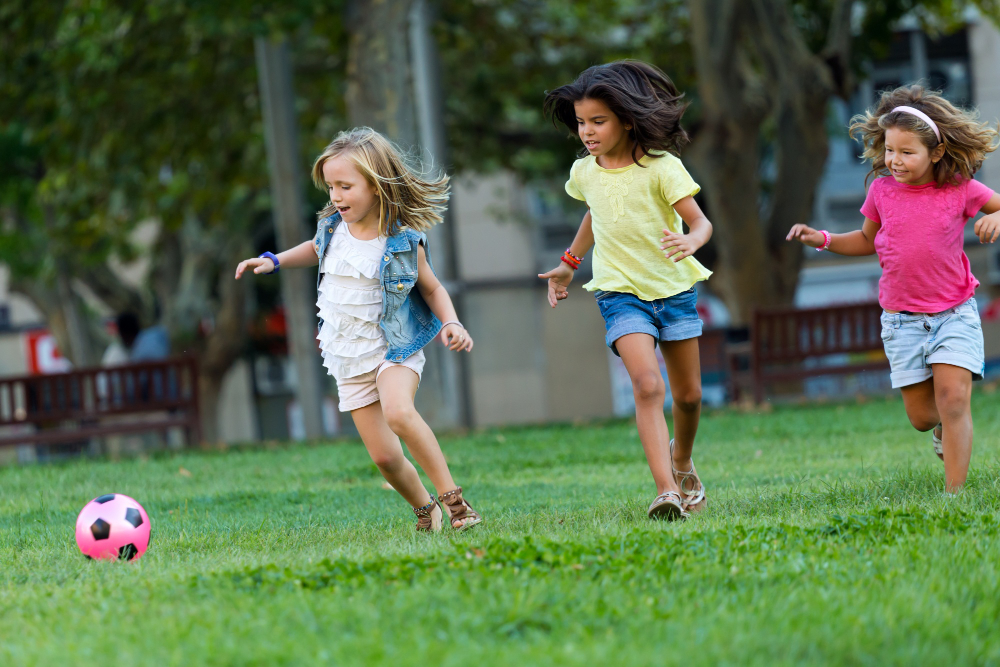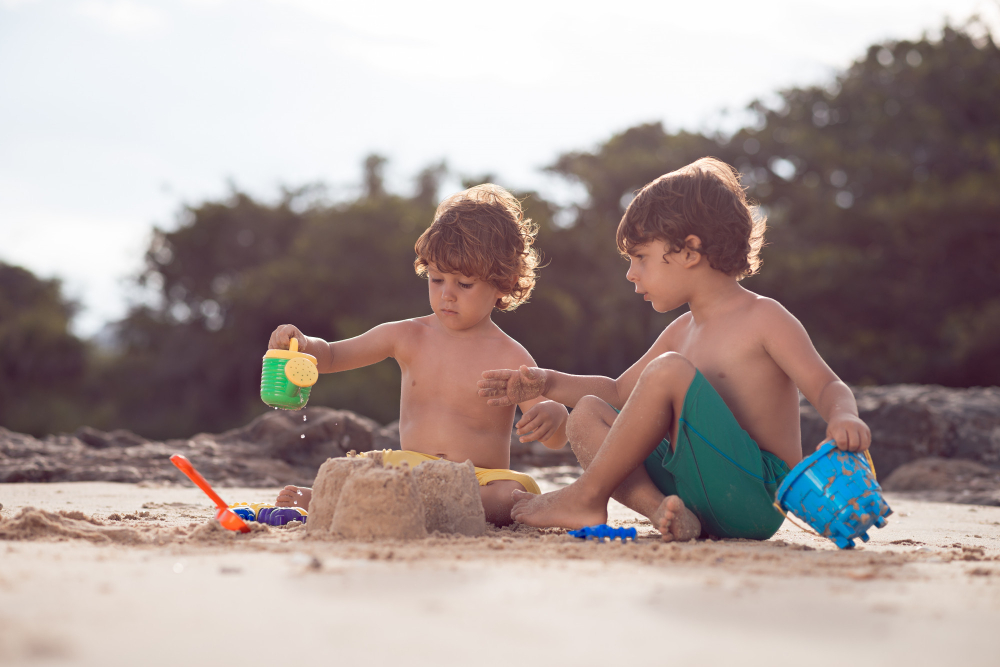23Oct
Keeping Your Little Sunshine Safe Under the Sun
The sun’s rays can be both beneficial and harmful to our little ones. As parents and caregivers, it’s our duty to soak up the good while protecting them from the bad. With a few practical tips, we can help our children play safely under the sun so they can glow with health – not burn with pain!
Understanding a Child’s Sensitive Skin
A baby’s skin is much thinner and more sensitive than an adult’s. Melanin, the pigment that gives skin color and blocks some ultraviolet (UV) rays, isn’t present in newborns and only develops as they grow. Tiny bodies also have larger surface area to body volume ratios, meaning they absorb more sunlight per pound than adults. Infants under 6 months should have zero unprotected sun exposure. Older babies and toddlers need safe sun habits too, as their skin remains highly sensitive to UV damage through childhood.

Practicing the 3 W’s – Watch the Clock, Wear Protective Clothing, Wield Sunscreen
The sun’s rays are strongest between 10am and 4pm. Scheduling outdoor activities for earlier or later in the day provides some natural UV protection. Seeking shade, especially during peak hours, is wise. When heading out under the rays, be sure to:
Cover Up With Sun-Safe Clothing
Babies under 6 months should avoid sun exposure entirely. After that, dress them in lightweight, loose fitting clothing that covers as much skin as possible. Opt for high-UPF-rated garments or tightly woven fabrics specifically designed to block UV rays. Wide brimmed hats, long sleeves, and long pants or skirts are ideal. To protect the eyes and delicate skin around them, have your child wear wide brimmed hats or baseball caps along with UV blocking sunglasses.
Apply Broad Spectrum Sunscreen Liberally and Often
Choose a broad spectrum, water resistant sunscreen with an SPF of 30 or higher for your child. Apply a thick layer 15 to 30 minutes before sun exposure. Reapply at least every two hours, or more frequently if swimming or sweating. Pay special attention to the delicate skin on the face, ears, neck, hands, and feet. Around eyes, use only ophthalmologist recommended products designed for that sensitive area. Apply sunscreen even on cloudy or cool days when burning potential remains deceptively high.
Seek Shade and Breaks from the Rays
Shading your child from direct sunlight is one of the best defenses against UV damage. Use shade structures, trees, or umbrellas to regularly rest kids out of the sun. Build breaks into outdoor plans to come completely indoors, cool down, hydrate, and reapply sunscreen in a shady spot. Avoid sun exposure when shadows are shortest at peak sun hours. Teach children to recognize and communicate when they need shade or a sunscreen recharge.

Special Sun Safety for Water & Snow Fun
When playing in and around water or snow, go beyond the basic 3 W’s of sun safety. Both water and snow can reflect up to 85% of UV radiation, intensifying exposure. Take the following extra precautions for maximum protection:
Cover Up With Rashguards and Specialty Gear
Have your child wear a tightly woven, long sleeved rashguard over their swimsuit. Consider UV protection swimwear or wetsuits for extended water play. Use water shoes or sandals rather than going barefoot to protect feet. When playing on snow, opt for tightly woven, breathable jackets and snow pants over other layers. Wrap-around sunglasses or goggles provide better eye protection from reflected glare.
Use Water and Sweat Resistant Sunscreen Formulations
Regular sunscreen can wash or sweat off easily. Choose “water resistant” or “very water resistant” formulas designed to last up to 80 minutes when swimming or sweating heavily. Apply an extra thick layer before water play, then reapply every 80 minutes of wet fun or immediately after toweling off. Look for creams rather than sprays or sticks which offer better water protection.
Time Around Midday Wisely
UV rays rocket toward their peak from 10am to 4pm. Schedule water play for earlier or later when intensity falls. Teach kids to regularly take shade breaks by coming completely indoors or in shady shelters near water/snow. Set alarms to remind you to reapply sunscreen and hydrate. When you can’t avoid mid-day fun, be extra vigilant with protective measures.

Teaching Sun Safety Early and Making It a Lifelong Habit
Our kids learn by observing and copying us. Set a stellar example with your own sun safety habits. Teach sun safe practices from early toddlerhood. With time and consistency, diligent sun protection will become an ingrained daily routine for your child.
Model Excellent Sun Safety Yourself
Always wear a hat, UV blocking shades, and sun protective clothing when outdoors. Generously apply broad spectrum sunscreen to all exposed skin on yourself. Seek shade near midday and remind kids it’s time to get out of the sun. Let kids see you drinking plenty of hydrating fluids. Explain what you’re doing and why as you follow sun safe practices. Your good example will stick with them for life.
Make Sun Safety Fun and Engaging
Spritz on sunscreen together singing songs to time application. Look for kid-friendly sunscreen brands with fun scents, colors, or designs they’ll enjoy. Play dress up choosing protective hats and sunglasses for style and function. Tell stories highlighting heroes using sun safety powers. Praise kids when you notice them making safe choices like moving to shade. Positivity builds habits.
Pack Protection and Set Reminders
Keep sun safety essentials ready to go for easy use when heading out. Pack protective clothing, hats, shades, and sunscreen in the car, stroller, or diaper bag. Set phone alerts for reapplication times. Place notes by doors as reminders to gear up. Make sun safety checklist charts or magnents kids can follow. Routines cement healthy habits for life.
Stay Vigilant About Mid-Day Sun
Help children recognize when UV rays are most intense by pointing out their shortening shadows around midday. Remind them to regularly cool off in shade during those peak hours. If staying inside isn’t an option, be extra strict about reapplying sunscreen and protective clothing. Keep a close eye so kids avoid overexposure when UV rays are strongest.
Detecting and Treating Sunburns
Despite excellent sun safety efforts, little ones may occasionally get a sunburn. Know how to spot sunburn, determine severity, and help your child find relief.
Identifying Sunburns
Look for telltale signs of sunburn like red or pink skin that feels warm or tender to the touch. It may be mildly or severely painful. Blistering, swelling, chills, and fever can also occur in more extensive burns. Young children are often unable to communicate sunburn discomfort clearly. Watch for crankiness, difficulty sleeping, refusal to move certain ways, or changes in typical behavior after sun exposure. Mild to severe sunburn warrants medical attention.
First Aid Relief Measures
For mild sunburns: Move to shade, gently cleanse with soap and cool water, apply aloe vera gel liberally and often to soothe skin. Give acetaminophen for pain per pediatrician instructions. Encourage fluids to rehydrate. Keep skin moisturized as it heals but avoid greasy ointments which may trap heat. For moderate to severe burns, seek medical care promptly. Prevent infection and alleviate pain as directed by your pediatrician. Watch closely for signs of dehydration or fever.
Avoiding Future Sunburns
Review what lead to the sunburn. Reexamine sun safety practices to prevent repeat episodes. Perhaps switch to a higher SPF sunscreen or be even more diligent about reapplying it. Buy UV blocking swimwear or hats to better protect vulnerable areas like the scalp. Tighten clothes weave or add layers. Stay completely out of midday sun. Double check guidelines with your pediatrician and upgrade sun safety efforts.

Special Sun Safety for Kids With Sun Allergies or Sensitivities
Some children develop polymorphic light eruptions (PMLE) triggered by sun exposure. This sun allergy causes an itchy or burning rash on exposed skin a day or two after sun exposure. Others have sensitivities that make them prone to heat rash. Take the following steps to help photosensitive kids stay safe and comfortable under the sun:
Heed the Sun Allergy Warning Signs
Note any rashes, itching, or burning that seems to occur or worsen with sun exposure. Mention these symptoms to your pediatrician. Keep a journal tracking reactions to pinpoint causation. Have your child tested for sun allergies if strong evidence points that direction. Don’t ignore or overlook discomfort, as sun allergies and sensitivities worsen with ongoing exposure.
Upgrade Protective Measures
Kids with sun allergies need maximum sun protection in layers. Seek tightly woven, darker fabrics in long sleeves and pants. Use highest SPF sunscreens, reapplying twice as often. Stay in peak shade during peak hours. Consider UV blocking films on car or home windows. Work with your pediatrician to identify all triggers and tailor a protection plan.
Treat Discomfort Promptly
If reactions still occur despite stringent sun safety, immediately get your child out of the sun then cleanse gently and apply soothing compresses. Chilled aloe vera gel can provide cooling relief. Give antihistamines or other medications recommended by your pediatrician to reduce itching and inflammation. Prevent scratching as this further damages skin.
Practicing Responsible Fun Under the Sun
Don’t let sun safety turn into sun shunning. Careful sun protection allows kids the joys of outdoor play while avoiding damage from excess UV exposure. With diligence and common sense, generations can frolic under the sun responsibly. Help your child glow with vitality, not burn with pain. Protect their precious skin today and set healthy sun safety habits for life!
